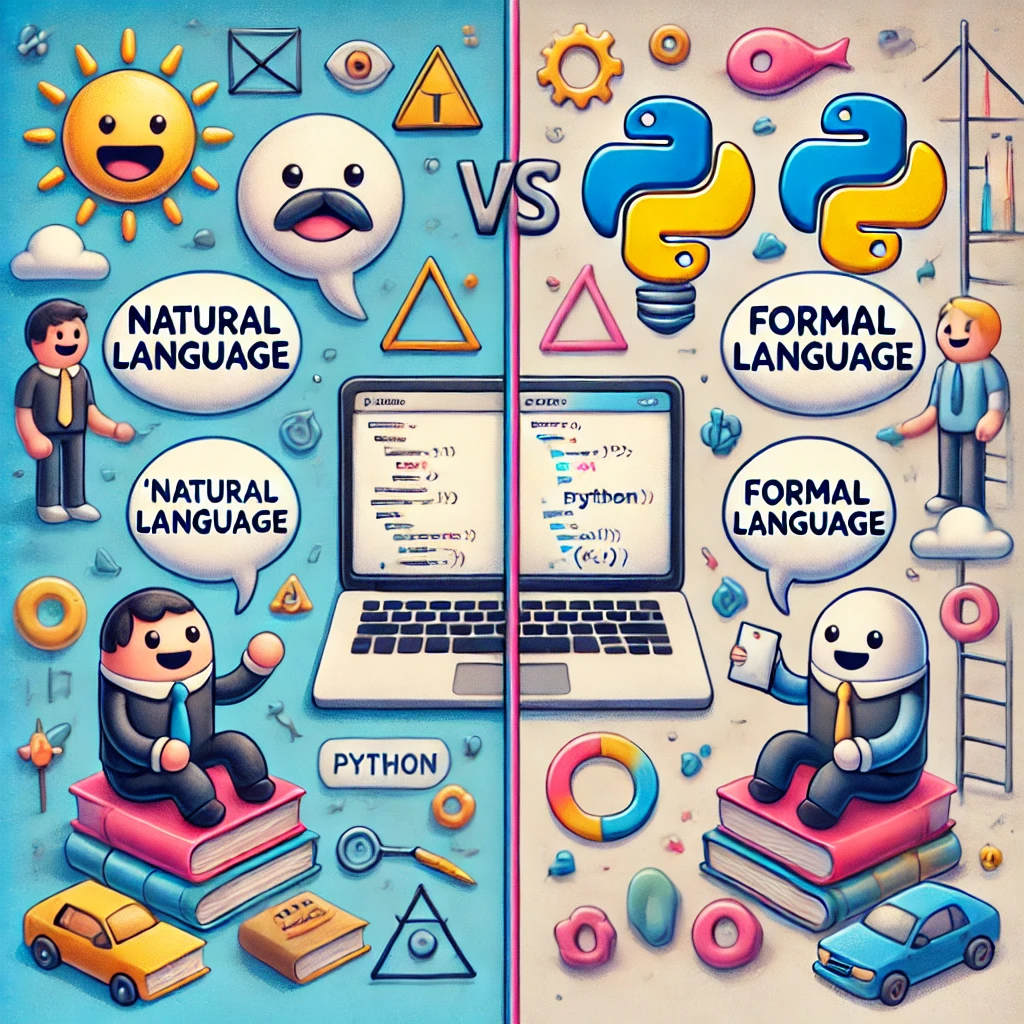📖 Formal and Natural Languages: The Engineer’s Playbook 📚#

Welcome to the linguistic battleground of programming! We’re about to explore two radically different worlds: the chaos of natural languages (like English) and the precision of formal languages (like Python). If you’ve ever wondered why your computer doesn’t understand your typos but your friends do, read on.
Natural vs. Formal Languages#
Natural Languages: The Messy Real World#
These are the languages humans speak—English, Spanish, Mandarin, Klingon (for some). They evolved naturally, and as much as we try to impose order, they thrive on ambiguity, idioms, and redundancy.
Example: “The other shoe fell.”
Meaning: Maybe something figurative. Maybe an actual shoe. Who knows? Depends on context.
Formal Languages: The World of Precision#
Designed by humans for specific purposes, formal languages are all about being exact and unambiguous. You’ve seen these in math, chemistry, and most importantly: programming.
Example:
print("The other shoe fell.")Meaning: Literally display the text
"The other shoe fell."on the screen. No ambiguity here.
Key Differences Between Natural and Formal Languages#
Let’s break it down:
Feature |
Natural Languages |
Formal Languages |
|---|---|---|
Ambiguity |
Full of it. Context is king. |
None. A statement means one thing, always. |
Redundancy |
Highly redundant (to reduce ambiguity). |
Concise and to the point. |
Literalness |
Often metaphorical or idiomatic. |
Means exactly what it says. |
Cheeky Example:#
Natural Language: “Break a leg!”
Translation: Good luck (no legs will be harmed).
Formal Language:
break_leg()Translation: Literally executes a function to break a leg (you monster).
An Engineer’s Toolkit: Understanding Syntax#
What is Syntax?#
Syntax is the set of rules that governs how we arrange elements (tokens) in a formal language. Get it right, and your code runs like butter. Get it wrong, and…well, your program will yell at you (hello, syntax errors).
Two Parts of Syntax:#
Tokens:
These are the building blocks—words, numbers, symbols, etc.Python Example:
print("Happy New Year for ", 2023)Tokens:
print,(,"Happy New Year for ",,,2023,).
Structure:
This is the order and arrangement of tokens. Tokens by themselves are not enough; they must follow the rules.Correct:
print("Hello, Engineers!")Incorrect:
print)"Hello, Engineers!("Why? Parentheses are all wrong, and Python is not amused.
Parsing: The Decoder Ring for Formal Languages#
What is Parsing?#
Parsing is figuring out the structure of a sentence or statement, whether in natural language or code. In natural language, you do this subconsciously. In formal languages, your brain (or the computer) has to work a little harder.
Example of Parsing in English:#
Sentence: “The other shoe fell.”
Subject: The other shoe.
Verb: fell.
Meaning: Probably something metaphorical…or not.
Example of Parsing in Python:#
Code:
print("The other shoe fell.")Function:
print.Argument:
"The other shoe fell.".Meaning: Display the text exactly as it appears.
Reading Programs: Tips for Engineers#
Programming languages, like poetry, demand careful attention to detail. Unlike poetry, they have zero tolerance for ambiguity or errors. Here’s how to tackle formal languages like a pro:
Take Your Time
Formal languages are dense. Don’t expect to skim them like a novel or text from a friend.Parse First, Read Second
Break the code into tokens and understand the structure before trying to interpret it.Focus on Details
A missed comma or a mismatched parenthesis can be catastrophic. In programming, even small mistakes matter.
Why This Matters for Engineers#
Formal languages like Python are your ultimate engineering tools. They help you:
Simulate complex systems with precision.
Analyze data without ambiguity.
Solve mathematical and physical problems systematically.
But they require discipline. If you’re sloppy, the computer won’t “guess” your intentions like a human would. Instead, it will refuse to cooperate until you fix your mistakes. (Think of it as a very picky coworker who’s always right.)
Passing Words#
Learning to program is like learning a new language—but better. It’s a language where every word, symbol, and punctuation mark has a clear, unambiguous purpose. Once you master this precision, you’ll be able to wield it across disciplines, from designing algorithms to simulating real-world systems.
So, buckle up. We’re about to leave the chaotic beauty of natural language behind and enter the world of structured elegance. Welcome to the world of programming! 🖥️
